From the Mayor's Office (Part 1)
There is no simple approach to building a Strong Town. There are no one or two universal ideas that, if implemented, will change the trajectory of America's cities, towns and neighborhoods. This is hard work. For a city to get there, current priorities need to be realigned and everyone -- from the mayor, the city engineer, the maintenance worker and everyone in between -- needs to be working to get more value out of our existing investments.
As a finale to the series we've been running that began with a simple comparison of the tax base from two nearby blocks -- one developed in the traditional pattern and one in the suburban -- I am going to share what I would advise a city's mayor to say in response. This is written as an address from the mayor to the staff.
Team,
I don't need to tell you that we are going through difficult times. You've all had your budgets cut in each of the last four years. Many of the things we used to do as a city, we are no longer able to. The trajectory we are on gives us little confidence that things will be different anytime soon. If we're going to tell ourselves that it's halftime in America, then we need to have the courage to make some dramatic, mid-game course corrections.
I've read the report from Strong Towns that showed how the 26-year tax increment subsidy we gave to relocate Taco John's resulted in a tax base, even before we deduct the subsidy payments, that is 41% less than the old run down block up the street. It surprised me, as I'm sure it surprised you, and caused me to do a lot of soul searching. And, quite frankly, it made me angry.
I'm sick of being told that our failure is some type of statistical anomaly. That decline in our core neighborhoods is normal. That we are destined to be a second tier city that fortune somehow passed by.
The thing I'm upset about is not how the report exposed our incorrect assumptions about growth and prosperity -- I'm actually grateful for that. The thing I'm upset about is what we've been doing to our own town, our own residents, our own families for these many years. We've done this to ourselves.
It ends today.
As of this moment, we're all going to be working with the same core goals with respect to the NE Brainerd neighborhood. In the next ten years, we are collectively going to work to accomplish the following hard, measurable goals:
- Double the tax base of NE Brainerd (8% per year average increase).
- Increase the total number of jobs in NE Brainerd by 150% (10.5% per year average increase).
- Increase the population of NE Brainerd by 50% (4.5% per year average increase).
- Hold budget increases for the city to less than 3% annually, an increase of just 30% over the next decade.
This is our only path to solvency. We need to grow our tax base, population and total jobs using the resources we have while not adding to our long-term liabilities. This is the opposite of what we've been doing. In real terms, our tax base has been in decline. We've lost population and jobs to the surrounding communities. In the name of growth, we've taken on a stunning amount of long-term obligations for infrastructure maintenance; liabilities we have no hope of meeting.
It ends today, and here is how we're going to do it.
Last week I contacted Mn/DOT and our representatives at the Minnesota Legislature to demand changes to the highway the runs through this neighborhood. It is the most destructive infrastructure we have for our overall tax base. I've laid out a proposal that would have our city be a laboratory for an experiment in shared space design. I've also formally offered to guarantee control of access rights and elimination of access points on the periphery of town -- something we've long fought against in the pursuit of strip highway development -- so highway speeds can be increased outside of town in compensation for slower speeds within. I'm optimistic this dialog will bear fruit as Mn/DOT is more desperate to reduce their long-term obligations than even we are.
As for our staff, here is what I expect of each of you.
City Engineer
I know this is going to be tough because you have the greatest course correction of them all. Listen closely. I'm not joking on any of this.
Tomorrow morning you are going to get all the paint you need and you are going to stripe every street in NE Brainerd. These streets are bizarrely wide; completely out of proportion for a neighborhood such as this. I want to see on-street parking areas defined, narrow (10 feet or less) driving lanes identified and the remainder of the space dedicated to bike lanes.
Yes, bike lanes. I want them everywhere and I want no ambiguity over what they are. I realize people are going to look at you funny as I'm sure very few residents in this area even own bikes anymore. Nonetheless, this is going to cost very little and it needs to be done. It is neighborhood triage. The first step of creating value is providing people with options. Today they have one. Tomorrow they will have one more.
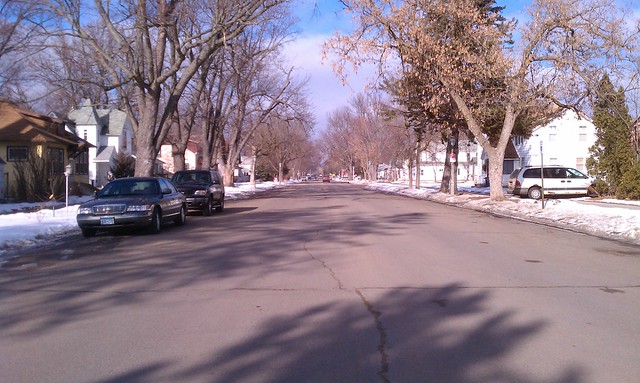
Stripe these streets. They are too wide and communicate car domination. Paint is cheap. Striping for bike lanes will add immediate value where little exists today.Next, I want to see a list of all the projects we have planned for this neighborhood for the next ten years. In each and every one, we are going to do three things. First, we're going to reduce costs dramatically by narrowing the pavement width. Our streets will be better looking and cheaper too. Second, we're going to redirect the savings into building quality sidewalks. Remember what I said about creating value by giving people options? Now they will have three (four after I get to the transit coordinator).
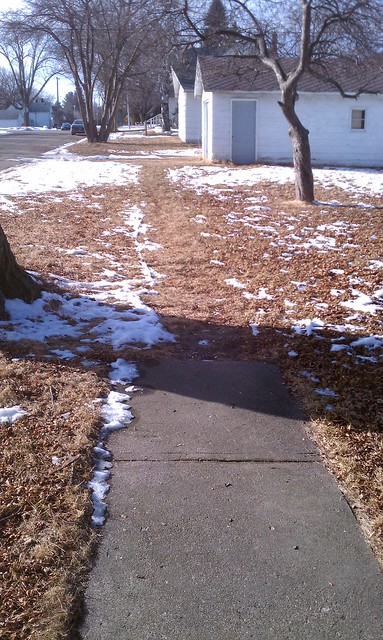
This isn't saving us money. It is wasting the hundreds of thousands of dollars invested in sidewalks elsewhere which are now cut off. This is how you kill a neighborhood. It needs to end.
And just so I'm clear about creating value through choice; if we're going to meet our goals, we need to work within a private market that is just as financially strapped as we are. Perhaps even more so. The more alternatives we give people -- for biking, walking or taking transit to get to where they need to go -- the more competitive we will be. If a family can move to NE Brainerd and only have to own one car, they save $8,000 each year by not having to have that second car. For $8,000 per year, they can spend $118,000 more on a house (which is more than most houses in NE Brainerd are worth). That's where we are going to get the private sector investments to turn this neighborhood around.
The third thing we are going to do with each project is to install urban vegetation. Not the quasi-nature stuff you're apparently fond of and not a bunch of weeds in a stormwater pond. We need vegetation that will be stately. We're building an urban neighborhood which is distinctly different from the suburban neighborhoods on the edge of town. It is subtle, but we need to get this right.
And as a final note, just so we're clear: your primary objective is no longer about moving cars. In fact, if we had to list your departmental priorities, that would be just about the last one on the list. Your top priority -- with no close second -- is to create value throughout the existing neighborhoods of this city. Not new neighborhoods on the edge of town. Not new growth out along the highway. Not to help people get to the WalMart in the next city more quickly. Throw away that hierarchical road system map that you have -- it represents an antiquated, 1950's mentality.
We're not about moving cars anymore; we're about building a strong town.
Planner
Your task is going to involve an equally dramatic shift in priorities and approach. I hope you are up to the challenge because right now, not only is the Planning and Zoning Department not creating value for this city, you are simply a bureaucratic obstacle to be overcome by anyone wanting to do something positive. I don't want to lose you -- I want you to be part of the team -- but the approach needs to change 180 degrees.
Let's start with a mental exercise. I want you to envision what a healthy, successful NE Brainerd would look like. What would be there? I know this is difficult because you and your predecessors have been focused on battling the symptoms of decline: a high percentage of rentals, poorly maintained properties, petty violations for trash and lawn maintenance, building code violations. What would success look like?
Let me help. Success would be a mix of housing options. There would be some rental, some owner-occupied. There would be a mix of types too. Some single-family and some multi-family. I'd also expect that a successful neighborhood would have both high earners and families on the low end of the wage spectrum. One should also expect to see a smattering of neighborhood commercial uses. All of these components would be intermingled and and designed to be completely compatible with each other.
Look at what our city code says. It calls for predominantly one use: single family. We have other "pods" of uses -- essentially arbitrary lines where we separate different types of housing from each other -- where multi family is allowed. These are next to our commercial areas because, ostensibly, poor people live in multi-family and they won't object as loudly to the terrible looking way we do commercial development.
Take a look at what our use-based code has gotten us in this neighborhood.
A lot of low value uses, like garages. Notice how this one is adjacent to the alley yet the cars access from the street, making this space not only look run down by design but also degrading the street, parking and pedestrian spaces.
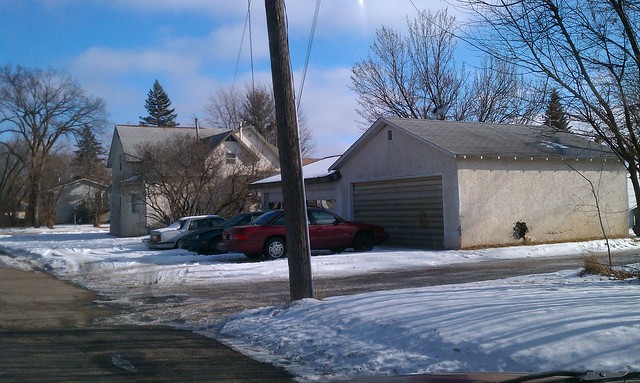
Use-based zoning doesn't care how the property interacts with the public realm. As a result, you get garages and cars framing the public space, even when an alley is readily available.We also have apartments being built. This is considered positive new growth, although it adds to the hostile feel of this "neighborhood". Many more of this type of building and we might as well just gate each property, put up watch towers and call in the national guard. This is a very anti-neighborhood design.
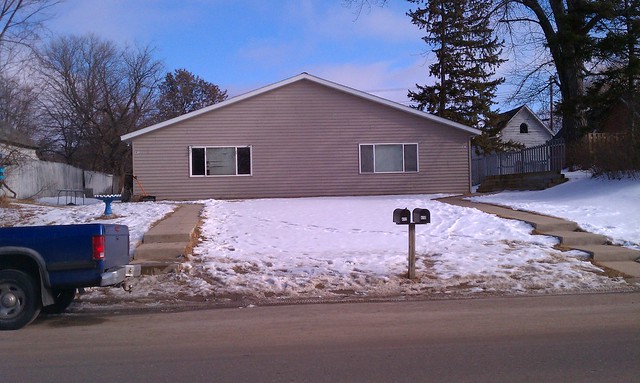
The use-based code only worries about how the building is being used -- apartment -- and whether it meets the setback, coverage and parking requirements. There is no concern about how this design detracts from the public realm and lowers the value all the neighboring properties.
Our current code also creates artificial buffers around properties, leaving unnecessary gaps throughout the neighborhood. I realize that many people believe we are "built out", but that is a ludicrous notion. We copied an ordinance from somewhere else, but we never stopped to measure our own neighborhoods and determine how it would mess them up. For us to reach our goals, the free market needs to be set loose to fill in gaps like these with productive structures.
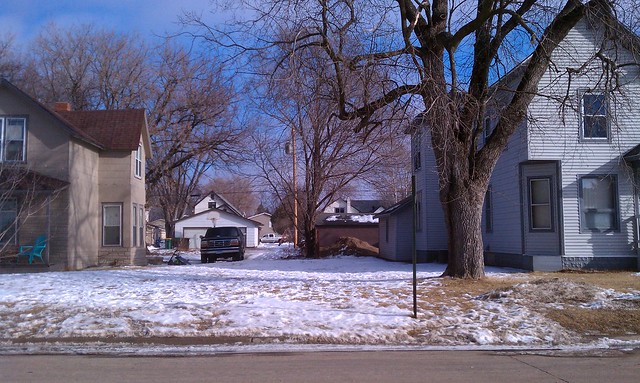
When suburban development codes are applied to urban areas it creates artificial buffering -- gaps -- in the urban framework. Not only does this artificially limit what property owners can do productively with their property, but in doing so it severely limits the tax base along with other measures that would improve the productivity of the place (like an additional utility connection on the same pipe).
Then we have the way that commercial properties interact with the neighborhood. We've designed them to be all on the edge and to be accessed only by automobile. Since the defining feature our ordinance demands is parking, we get buildings that have huge parking lots and, thus, face the parking. Here is what our residents get to look at from their homes. Not exactly creating much value for them.
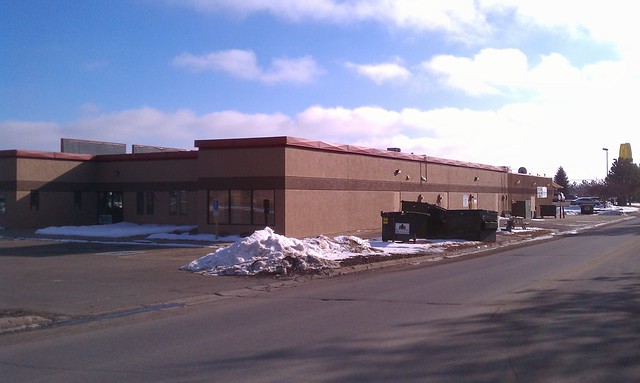
Can we expect our neighborhoods to thrive when we allow them to be treated like this? Why do we allow these commercial properties to not only not provide any access to the people living right across the street (they must drive like everyone else), but we allow them to point their unadorned rear, complete with dumpsters, right at them. To create a neighborhood with value, we need to show it respect.
In fact, we routinely sacrifice the quality of life for our residents, along with their property values, on the alter of new growth. That is a tradeoff that has not served us well and one I am no longer willing to make. Any new development needs to add to the overall value of what is existing, not detract from it.
Today I am going to propose an ordinance that will repeal our entire zoning code. Six months from today, it will cease to govern this city. I would rather have no code than the one we have now, but I do believe that a mixed-use, form-based code with a streamlined approval process would have great benefit for this neighborhood. You have six months to have it in place.
Here are the parameters I expect from a new code.
- It must provide for a mixture of uses within neighborhoods. Limit commercial properties to the intersections if you must, but they must be allowed throughout.
- It must provide for a mixture of housing styles. We have to allow the neighborhood to mature. We're not omniscient enough to say exactly where that will happen and when so we need to get out of the way and let it happen naturally.
- We must regulate how structures address the public realm. Everything that is built from this point forward needs to improve the public space. No more bare walls. No more side entrances. No more garages out front. If we want people to invest in this neighborhood, they need to travel throughout it and know that their investment will be respected.
- There will be a build-to line -- not a setback line -- to ensure that all structures properly frame the public realm.
- All garages and parking areas shall be to the rear of the lot, always behind the dwelling. They will be accessed from the alley where one is available. We're building a neighborhood for people to live in, not cars.
- Approvals for construction under this code must be able to be done within two hours. People need to know clearly what they can do, they need to be able to walk into city hall and then walk out that day with a permit. No long public hearing process. No ambiguity. If the form of their building meets the code, I want it approved. We are going to be the least bureaucratic regulatory department in the state.
Oh, and there will be an immediate ban on new surface parking. The entire neighborhood we are looking at is eight blocks square. Theoretically, if our streets were not so hostile to pedestrians, the entire place is within walking distance of itself. Despite that, people rarely park on any of the streets. Surface parking is a cancer on the tax base. There will not be another surface parking lot built until all those on-street spaces we pay so dearly for are filled.
Our obsession with rental properties is over. We do not have a problem with rental properties, or better put, rental properties are not the problem. They are the symptom. The problem is neighborhoods that lack value and reasons for people to invest in their future. Your job is no longer to fight over rental properties. It is no longer to administer red tape or checklists, to ensure that each use is in its proper place, that there is enough parking for each Black Friday rush of vehicles.
Your job, plain and simple, is to improve the value of the public realm. If you make our public spaces -- the space between structures spanning across the street -- more valuable, our neighborhood will grow and prosper and we will meet our goals.
I'll continue this dialog next week as our mayor addresses Economic Development, Parks and Recreation, Housing Rehabilitation Agency, Public Utilities, Maintenance, Transit, Public Safety, the property tax system and the city's school district, churches and civic organizations.
Thank you to everyone that has been following this series from the beginning of 2012 until now. We've appreciated your feedback. If you would like to support our efforts to get this message out to more communities, please consider supporting us with a tax-deductible donation. We are a 501(c)3 non-profit working to spread a timely message of resiliency across the United States. Thank you for your support.
